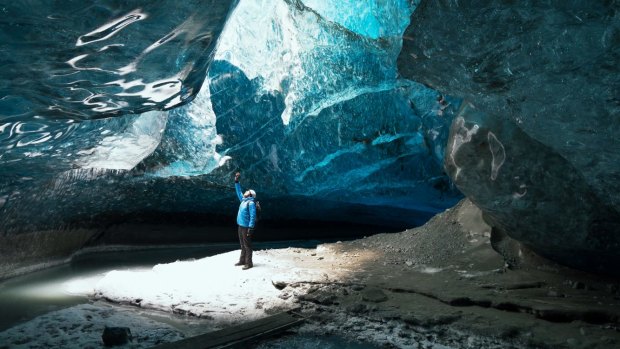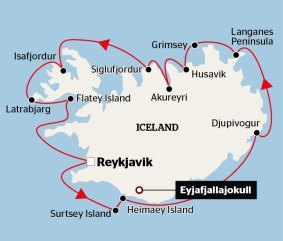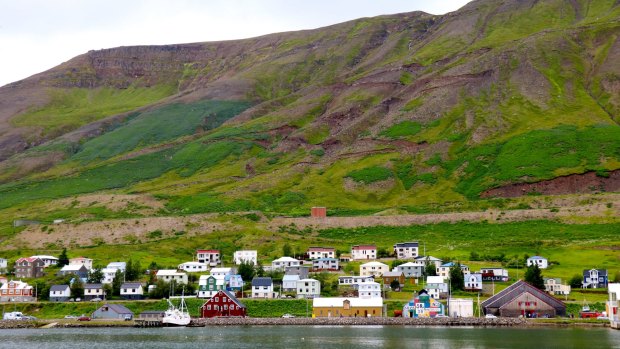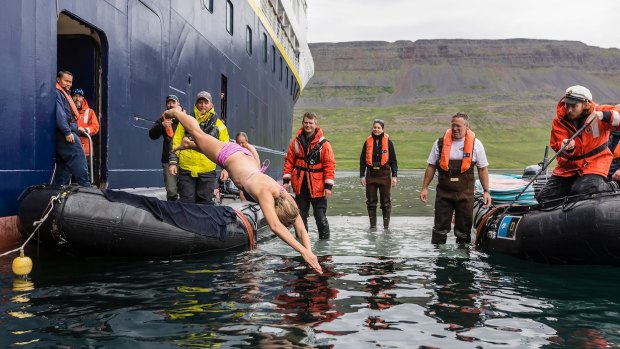This was published 7 years ago
Iceland cruise: How to see this tourist hotspot without the crowds

Iceland has become a tourism hotspot.Credit: SHUTTERSTOCK
It's an overcast morning when our ship, the National Geographic Explorer, drops anchor in a quiet fiord in northwest Iceland. Those of us still at the breakfast buffet peer out the windows at a world of stillness.
While the crew readies a dozen inflatable kayaks, my shipmates and I dash to our cabins, throw on thermals, fleeces, waterproofs and lifejackets and head downstairs to the "mud room" where we're given EPIRB-like necklaces that remind us where we are: in a faraway corner of one of the world's wildest countries.
This is no follow-the-leader paddle. Instead we pair up, lower ourselves into the two-person kayaks and push off into the view, free to go where we like.

The cruise route.Credit: Fairfax Media
At first my paddling partner and I drift, wowed by our surroundings: a U-shaped glacial valley, green walls curving upwards from sea level into a ceiling of low cloud, a speck of a farmhouse on the far shore. Behind us is the Greenland Sea, the water polished steel.
Then, movement: a North Atlantic puffin, a few silvery sand eels clamped in its harlequin beak, takes flight, red feet running on water, until, in a frenzy of flapping, it's airborne.
Watching it fly off into the empty landscape, I start to wonder: where are all the other tourists?

Siglufjordur.Credit: Louise Southerden
ICELAND BY SEA
"This is a true expedition," our Kiwi expedition leader Brent Stephenson had said on our first night as we'd steamed out of Reykjavik and east along Iceland's south coast.
Everything about this 10-day voyage conspires to give the impression we're exploring, from the open atlas under the glass-topped desk in my cabin and the open-bridge policy to the expedition team of adventurer-naturalists and National Geographic photography instructors.

Taking an Arctic plunge.Credit: Michael Nolan
Then there's the fact that this is Lindblad Expeditions' first anti-clockwise circumnavigation of Iceland. "We're still exploring," our Swedish captain, Leif Skog, tells me on the bridge the next morning.
It seems apt to port-hop around a nation first settled by Vikings and built on fishing: all week we glide into roadless fiords, step ashore at working wharves and circle island curiosities such as Surtsey and Grimsey – one born from an undersea volcano in the 1960s, the other the only bit of Iceland north of the Arctic Circle.
There are two divers on board too, who wriggle into drysuits at every opportunity to bring back GoPro footage of underwater Iceland's sea stars and kelp forests, moon jellies and decorator crabs.
"We're seeing Iceland as few people get to see it," says the trip's whale specialist Steve Zeff, hinting at another advantage of travelling by sea: sidestepping Iceland's tourism boom.
VOLCANO-INSPIRED TOURISM
Iceland is one of the world's hottest destinations now, thanks to a perfect storm of man-made and natural disasters with a dash of pop culture. First came the 2008 financial crash when the Icelandic krona dropped in value, making the country once dubbed the Dubai of the North suddenly affordable. Then the unpronounceable volcano erupted in April 2010, disrupting flights across Europe for six long days.
"This whole thing really took off following the Eyjafjallajokull eruption," says historian and journalist Magnus Sveinn Helgason, who runs Walk the Crash tours of Reykjavik.
"Icelanders thought 'Oh, another blow: first the banks fell, now the volcanoes.' But in reality this was free advertising for Iceland, because night after night on all the news programs around the world, people saw these pictures of volcanoes and glaciers and thought, 'This place looks amazing, we have to go there!' "
Promote Iceland ran with it, creating a campaign to reassure tourists that Iceland was safe after the eruption. Icelandair started offering free stopovers for passengers flying between North America and Europe. Then Iceland's bleak beauty stepped into the spotlight – as a location in Game of Thrones, movies such as The Secret Life of Walter Mitty, even Justin Bieber music videos.
Now Iceland is having its time in the midnight sun: tourism has been growing at 20-40 per cent a year for the past seven years and the number of foreign tourists has almost quadrupled from about 490,000 in 2010 to 1.8 million last year with 2.3 million expected this year, mostly from the US (source: Islandsbanki).
THE NEW ICELAND
Reykjavik right now is a city of cranes as new hotels and hip hostels spring up. All over the country, there are new tour operators, new activities, improved roads. Iceland could get its first train, an airport-city link, by 2025. The international airport at Keflavik, which saw a record one million passengers passing through in July this year, is undergoing expansion and regional airports are stepping up to share the load.
New camping and road rules have come into effect (banning wild camping and off-road driving) and this year restrictions were placed on Airbnb rentals – which earned homeowners an estimated 6.7 billion ISK ($80 million) in 2016, not bad for a population of less than 340,000.
There's a shadow side to all this growth, including fears of rising costs (for locals too) if a proposed "tourist tax" is introduced to fund much-needed infrastructure. But a Barcelona-style backlash against tourists is unlikely, says Helgason.
"People blame the authorities, not the tourists, for the lack of affordable housing or inadequate walking paths at waterfalls or the lack of public lavatories along Iceland's roads," he says, and a recent Visit Reykjavik poll found that nine out of 10 Reykjavik residents are positive towards tourism.
Above all, Icelanders seem to take a pragmatic attitude, says tourism consultant Dagny Ivarsdottir. "Yes, it's maybe negative that we have to share our country with more people," she says, "and there's always the fear of ruining nature sites and we've had to actually put up ropes and signs and originally the appeal of Iceland was: there's no borders, no laws, you can camp wherever you want.
"But the positives are that there's so many jobs being created and so many services and restaurants, public transport that we're now able to sustain because of all the extra people. And new air gateways have opened to Iceland [25 airlines now have scheduled flights to Iceland, up from seven in 2009], which also allows us to escape!"
TOURISTS, WHAT TOURISTS?
And here's the thing: Iceland doesn't feel crowded. Not just because we're travelling by ship, gliding at a genteel distance from the coast. It's because for a small island – slightly smaller than New Zealand's North Island – Iceland is a big place; its tourist density is way lower than the European average, in fact (16 versus 103 people per square kilometre).
Tourism might be the talk of every town: all week we hear about guesthouses that used to be nursing homes, gas stations that are now restaurants, farmers who now drive tour buses. And some spots are awash with selfie sticks, high-heeled tourists and rental cars. But you only have to drive five minutes down the road to find yourself alone again with mountains and volcanoes that put humans back into puny perspective.
Travelling by ship actually lets us alternate between these two worlds: wilderness and must-see attractions, often on the same day.
On the morning of day three, we step ashore at Djupivogur on the southeast coast and drive for a couple of hours along Iceland's Ring Road, which circles the island in one scenic 1332-kilometre loop.
Breezing past campervans and rain-spattered cyclists along the southeast coast, we peer down at black-sand beaches, cross bridges over glacier-fed streams, see wildflower-dotted meadows and marshmallow-like hay bales wrapped in pink plastic.
SUMMER SNOW
Our destination that day is Vatnajokull. Europe's largest glacier in its largest national park covers almost 10 per cent of Iceland. We'd seen it from the ship the previous night, this vast, flat-topped ice mountain. It's even more impressive up close – or would be if we could see it.
It's a whiteout, in July, but there's no such thing as bad weather in Iceland. After putting on safety-red snowsuits and motorbike helmets, we choose our steeds: two-person snowmobiles. My co-driver, Nina from New York, laughs hysterically as we try to keep up with our blonde Viking of a guide.
"I keep thinking, 'I wonder what this place is like in summer!' " she shouts over her shoulder when it's her turn to drive.
That afternoon, we're back in tourist-land at Jokulsarlon, Iceland's deepest lake. It's crawling with people, we've had to book a time slot for the amphibious boat ride and our guide is French ("I came to Iceland for the weather!" he grins through rain squalls) because there aren't enough Icelanders for all the tourism jobs now.
But it's still otherworldly to drive down a gravelly beach and onto the water, where we putter around icebergs spawned by an offshoot glacier that flows down from Vatnajokull.
HORSES AND HERRING
Every day we go ashore, every day there's an opportunity to be active. As well as kayaking and snowmobiling, we get the chance to swim in the North Atlantic (it's an exhilarating nine degrees) and do after-dinner hikes to thundering waterfalls.
On day six we get to ride Icelandic horses, mine a mare called Berta ("brightness"), through stirrup-high grass along the edge of a fiord surrounded by snow-capped mountains.
That afternoon, we're in Siglufjordur, once the epicentre of Iceland's herring fishing industry. Hundreds of ships would fill its small fiord-harbour, thousands of fishermen and "herring girls" came for the seasonal work – until 1968 when the herring stocks collapsed from overfishing.
Siglufjordur became a ghost town, until 1994 when a group of teachers decided to preserve a couple of the old wharf buildings and opened a small museum to tell the town's story. Two thousand tourists came that first year, most of them Icelanders. The museum expanded, more buildings were restored and last year it had 25,000 visitors, mostly foreigners like us who get to dance to accordion music with a new generation of herring girls on the timber deck under the sun.
ICELANDERS RULE
Expedition cruising is usually self-contained, with activities such as Zodiac cruises run by the expedition staff on board. On this trip, land-based tours give us the chance to interact with the locals in situ.
"This is the wettest summer since 1972," says Lisbet, our guide in Isafjordur on the north coast on day seven, as we drive to the start of a short hike. "We haven't been able to get out of our darkness depression yet. So I apologise on behalf of God. And for my sarcasm and irony. I wish I could just get you drunk!"
She tells us about life in small-town Iceland (only a third of the population lives in Reykjavik): the avalanches in winter, the fact that everyone in Isafjordur knows how to either sail or fly a plane, her five kids are well-behaved because Iceland has 13 Santas and their cat eats naughty children, and most people believe in trolls, elves, changelings and other "hidden people".
Not that there isn't plenty of Iceland on the Explorer too. Icelandic singer-songwriters play for us in the lounge every night. There are talks, films and lectures about Icelandic politics. We even get to taste Icelandic foods (dried haddock, anyone?) and learn how to pronounce Eyjafyalljokull and that there's so little crime Icelandic police officers keep busy posting to Instagram (and have 162,000 followers).
NEXT STOP: SLOW DOWN
What's next for Iceland's tourism industry? "I don't think Iceland will stop being a popular destination, but we're seeing changes in the way people spend their money," says Dagny Ivarsdottir. "Fewer people are spending money on recreation and day tours and food. Instead of buying a glacier hiking trip or a rafting trip, they will just rent a car and do it on their own … What's really going well is cruise tourism, I guess because they're not using hotel rooms and it's easier."
But a slow-down is inevitable, says Helgason. "There are already clear indications that growth is slowing – hotel stays this summer increased by just a couple of per cent over last year and there was even a drop in tourism in northeast Iceland, the Westfjords and other areas far from Reykjavik – because of the stronger Icelandic krona; foreign visitors are now paying 20-30 per cent more to come to Iceland.
"Iceland is fashionable right now, no question about that. But even if it would become slightly less 'in', none of the things that made it popular in the first place will vanish: the amazing views, dramatic landscapes, aurora and midnight sun. At a time when travellers are also increasingly worrying about safety, crime and terrorism, Iceland will also continue to have an appeal as the most peaceful country in the world." (Iceland has topped the Global Peace Index every year for the past 10 years.)
WHALE OF A TIME
At the farewell cocktail party on our last night, Captain Skog tells us we've cruised 1265 nautical miles in 10 days. That's about 2400 kilometres – 1000 kilometres more than the Ring Road.
On land we'd seen volcanoes and glaciers, glumping mud pools and steamy geysers, walked to waterfalls and into forests of Siberian larch. At sea, between lectures and meals and sometimes interrupting them, we'd seen humpback whales, dolphins, seals, a basking shark (the world's second largest fish after the whale shark) and a blue whale, the largest animal ever to have lived.
That last day we'd even cruised past Europe's longest bird cliff, Latrabjarg, an avian apartment block 400 metres high and stretching 14 kilometres along one side of Breidafjord in northwest Iceland where we stand on deck to watch thousands of puffins, kittiwakes, gulls and guillemots.
We relive it all over our last a la carte dinner that night. Then, because of an early disembarkation in Reykjavik the next morning, everyone retires early.
Well, almost everyone. "Just when you thought the trip was over," says expedition leader Stephenson over the PA just before 11pm. Orcas have been spotted ahead of the ship, he says. "I suggest you throw on a bathrobe and get out onto the bow or up to the bridge."
I can't think of a better way to end a voyage around Iceland than this: standing in my pyjamas on the bridge of an expedition vessel on a darkless night off the remote west coast, watching seven orcas so close we don't even need binoculars.
For more than an hour they breach, tail-slap and roll upside down, exposing their paper-white bellies. It's a show, a privilege, on their terms – we're not chasing them, they come to us – and we're the only ones to see it. There are no other ships in sight, no buildings or people on shore. We could be the only humans on Earth, or in Iceland.
TRIP NOTES
MORE
FLY
Finnair flies from Sydney, Melbourne and Brisbane to Reykjavik via Asian cities such as Singapore and Tokyo, and Helsinki. See finnair.com/au/gb/ Australians don't need a visa; Iceland is part of Europe's Schengen Area.
CRUISE
Lindblad Expeditions' 10-day Circumnavigation of Iceland cruises on the 148-passenger National Geographic Explorer run in June and July and start at $12,840 per person including: all meals, bar tab, crew tips, shore excursions and activities, port charges, photography instruction and transfers for group flights. See au.expeditions.com
Louise Southerden travelled as a guest of Lindblad Expeditions.
FIVE MORE OFF-TRACK ADVENTURES
1. TAKE A HIKE
Laugavegur Trail in the central highlands is being loved to death so try instead one of the walks in East Iceland, such as the Seven Summits around Seydisfjordur, all over 1000 metres. See east.is/en/
2. STAY IN A LIGHTHOUSE
The lighthouse in Hornstrandir Nature Reserve in remote northwestern Iceland, just south of the Arctic Circle, is one of 15 "mountain huts" managed by the Iceland Touring Association. See fi.is/en
3. DIVE WITH THE PUFFINS
Sure it's cold, but the rewards of diving and snorkelling in Iceland include incredible marine life, 100-metre visibility, geothermal chimneys and the chance to see puffins "fly" through the water. See strytan.is/
4. CATCH A WAVE
Surfing in Iceland isn't just for the hardcore. It's about experiencing the country's "raw natural beauty", says Ingo Olsen, founder of Arctic Surfers, Iceland's only surfing tour operator. And if there are no waves, they arrange other adventures. See arcticsurfers.com/
5. RIDE WITH WILD HORSES
Four-day rides with up to 40 "free running" Icelandic horses start near Akureyri in northern Iceland; you'll get a chance to ride three or four horses and stay in a turf house with no electricity, running water or Wi-Fi. See skjaldarvik.is/en
FIVE WAYS TO BE A THOUGHTFUL TOURIST IN ICELAND
1. BE PREPARED
Watch Promote Iceland's fun Iceland Academy video clips for tips on everything from what to pack and driving safely to taking "safe selfies". See inspiredbyiceland.com/icelandacademy/
2. GO IN WINTER
Visiting in winter helps spread the tourist load and has advantages over summer: fewer people, lower prices, the Northern Lights and skiing. And it's not as cold as you'd think, because of the Gulf Stream.
3. GET OUT OF THE CAR
Iceland's dependence on renewable geothermal and hydro energy makes it one of the cleanest countries in the world, but tourism is increasing its carbon emissions (rental companies bought 42 per cent of new cars sold last year). You can help by driving less and hiking more.
4. SPREAD OUT
Share the tourism love beyond the popular Golden Circle in the southwest by exploring Iceland's north, east and west; Air Iceland Connect flies from Reykjavik to Akureyri, Egilsstadir and Isafjordur. See airicelandconnect.com
5. DON'T EAT THE MINKES
Whalemeat isn't traditional Icelandic fare but tourist demand is perpetuating commercial whaling. Go whalewatching instead and see icewhale.is for a list of whale-friendly restaurants.
Sign up for the Traveller Deals newsletter
Get exclusive travel deals delivered straight to your inbox. Sign up now.